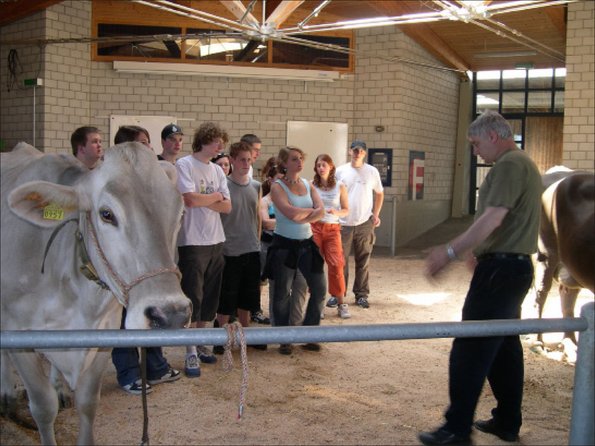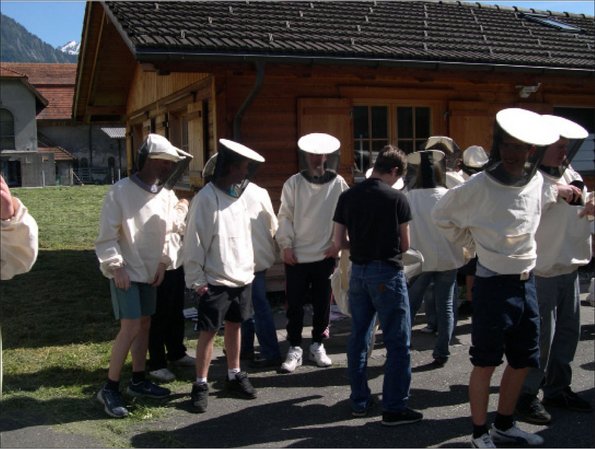Rubber boots instead of kitchen apron
Rubber boots instead of kitchen apron
Cooking apprentices gain know-how in stable and field
by Heini Hofmann
The modern agglomeration society has a problem: It lacks the dung on its sleeves! While the farmer’s seed is shrinking, the consumer base, which is alienated from plaice, is exploding. This leads to a loss of contact between the original producer and the end user. That is why direct bridging with first-hand information is necessary. Because only this has a credible and lasting effect.
A prime example of this are the taster days of cooking apprentices at the Allgemeine Berufsschule Zürich (ABZ) (Public Vocational School) in the Landwirtschaftliches Berufs- und Bildungszentrum (LBBZ) (Agricultural Career and Training Centre) Plantahof in Landquart, so to speak a “rubber boot instead of cooking apron” experiment. The future preparer of original products are not only taught basic knowledge, but they acquire a multiplication effect in their future working life.
Back to the roots
While Rousseau has already called for a “Retour à la nature”, a “Return to agriculture” is now necessary for broad sections of the population. The modern urban and agglomeration youth knows exotic wild animals better than native farm animals, that most of them encounter as sophisticated consumers only, beyond their own horizon. The fact that nature produces fruit and vegetables on a seasonal basis is totally forgotten by wholesalers due to the permanent offers that have become a matter of course.
No wonder that such alienation leads to a loss of understanding for tangible biological-ecological connections, which encourages unrealistic demands, both with regard to exaggerated consumer demands (white veal) and in the direction of extreme animal welfare demands (meatless society) – both indirectly expressions of an overall socially unpleasant feeling or even a bad conscience about suppressed, i.e. delegated responsibility.
Years ago, this alarming situation gave the unequal school administrations in Zurich and Landquart the impetus to build a 1:1 bridge between agriculture and gastronomy. It has proved so pleasing that it has become a firm tradition and at the same time a highlight in the training of the cook apprentices in the 1st apprenticeship year in the so-called interval teaching. It takes place in May annually.
Key skill
It’s always the same: The boys and girls of the future cooking guild compete in a cheerful and relaxed school travel atmosphere, not knowing that after these intensive days of experience with extreme early rising and practical hands-on experience in near-natural outdoor lessons in the fields and in the stable, they will return home happy but dead tired and with permanent dung on their sleeves. One thing is certain: The demand of the economy to increasingly impart key qualifications to apprentices can probably nowhere be fulfilled more sustainably than in such practical lessons on the production front.
First, the agricultural novices are allowed to put their ideas about the farmers’ profession on paper – which is quite romantic. After that they are introduced to the reality of modern agriculture, where hard work is done at the rhythm of nature and by the dictate of the market and structural change. Certain parallels to the current situation in the gastronomy become obvious and one gets closer immediately.


From bee to beef
Then they have to put on the boots. Initially, the hefty smell in the pigsty leads to sniffing. But soon the interest in these intelligent, clean by nature and most consumed animals is dominating (the average Swiss eats half a sow per year).
In dairy cattle, the great annual and life achievements are imposing. It is possible only with optimal keeping, feeding and care. One is astonished to note that the handling of free-range and therefore semi-wild suckler cows is quite different from the handling of more trusting dairy cows during day-to-day milking. When taming the young bulls, the only methods à la Monty Roberts help: bull whisperers instead of horse whisperers.
But the smaller product suppliers among the farm animals are also of interest. Who would have known that not the white chicken lays white and the brown chicken lays brown eggs, but that the colour of the eggshells is genetically linked to the colour of the external ear, i.e. that chicken breeds with white earlobes lay white eggs and those with red earlobes lay brown eggs. Or the enormous importance of flower pollination by honeybees in plant and fruit growing, even that there would be neither fruit nor vegetables without bees!
Ecology and regional products
Then it’s from the stable to the field getting to know the difference between permanent grassland and artificial meadows (which replace the former fallow wasteland) and between open farmland and special crops, including the associated terms such as crop rotation, variety selection, organic areas, weed control and the promotion of beneficial insects, i.e. optimum income generation without damaging the soil.
The fact that organic agriculture means not only reduced income but also increased manual work can be experienced by the prospective cooking apprentices themselves with the tedious weeding (weeds with miserably long roots) by hand instead of chemical mace. Finally, the topic of regional products is on the agenda, impressively demonstrated in the school’s own and in the private farm cheese dairy of the Marugg family in Klosters, as well as in the Mark speciality butcher’s shop with its own slaughterhouse in Lunden above Schiers: flourishing family businesses where work is done by hand and heart, the pleasant opposite of mass production.
Worth copying!
In short: From the “rubber boots instead of cooking aprons” experiment, the budding cooks return to school life in Zurich full of impressions. It remains the beautiful prospect for their former guests to know that these chefs of the kitchen brigades have some dung on their sleeves despite their white work clothes, which means that they know where and how the products originated which they prepare for their guests. Therefore: The ABZ Zurich/LBBZ Plantahof Landquart campaign is a meaningful and profitable experiment that deserves to be copied throughout Switzerland! •
(Translation Current Concerns)
Pioneering spirit at Plantahof
HH. Where once the stagecoaches got stuck in the swampy Riedland, in the area of today’s Plantahof in Landquart the Präzer cattle shepherd Thomas Lareda, after he had become rich as a sugar baker in St. Petersburg during the tsar era, bought a small farm in 1811, the Schnideri Bündt, which was renamed “for the sake of the Russians” in Russhof.
Brown cattle instead of cotton
After Lareda died of influenza in 1848, the now greatly expanded property, which had in the meantime belonged to Christian Luzi, an agency operator for emigrants, passed to the 25-year-old Rudolf Alexander von Planta, born in 1861 in Egypt as the son of a cotton magnate, whose dream was to become a farmer. Von Planta was one of the modernists at that time of setting the course in the Canton of Graubünden cattle breeding (small Graubünden grey cattle versus large Schwyz Braunvieh, (the brown cattle)), charactised by the successful breeding techniques he had acquired in England. Unfortunately, he died in 1895, almost 35 years old, much too early from an malicious kidney disease.
In his last will – this was the basis of the Plantahof Agricultural School – he used the Canton of Graubünden as universal heir, but attached the condition to keeping a cattle herd of the Braunvieh breed at all times and thus alimentating the national breeding. The Plantahof has adhered to this. And in general, a particularly strong pioneering spirit can still be felt here.
The cow who cries
HH. How far modern society is from agricultural roots is shown in daily examples: A kindergarten teacher and the peasant woman visited by her do not believe their eyes. Several of the dozen natural orphans brought along from the agglomeration dig themselves into the soil – like small piggies. And another titch runs across the clover mat with his arms outstretched. Obviously the first intensive experience with pastures and earth. If this is not food for thought!
However, such a phenomena is not only limited to the youngest of the alpine farmer- and shepard- nation. “Do potatoes grow on shrubs, where the flowers are?“ asks a fourteen-year-old daughter from the city naively showing interest in the farmer with whom she keeps her horse. Or a twelve-year-old pupil, celebrated as computer champion by his classmates writes unconcerned in an essay: “Milk is produced in a factory; Migros and Coop have different procedures.“
And conversely, advertisers in stylish city offices are worried about how to promote milk consumption, namely by freeing the white juice from its rustic image of origin, i.e. from the cow-owder and thus from the stable and muck surrounding. The result: The “glass of cold milk“ is dead, now the “ice milk drink“ is in. Such developments will surely cause the good cow Lise to get tears in her eyes!
Therefore, such a direct connection with first-hand information, as in the campaign “Rubber boots instead of kitchen apron“ achieves, is more just what needs to be done.